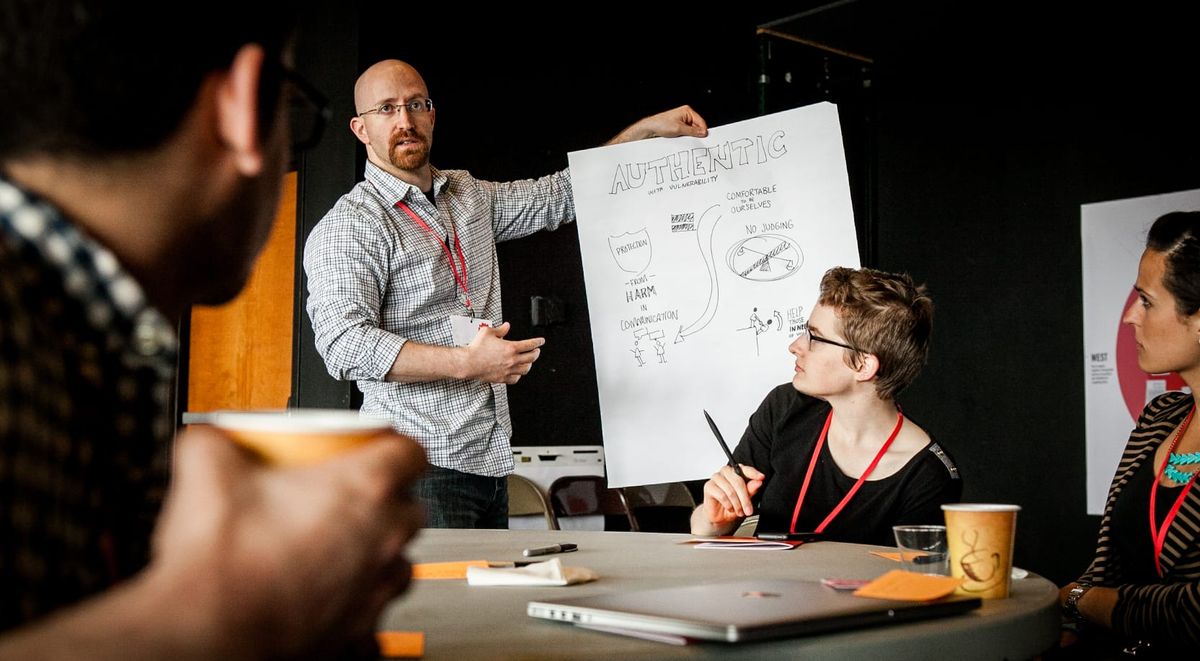
Improve Your Communication Skills at Work a Step-by-Step Guide
You need effective communication in the workplace. This guide shows you which skills matter. How they drive success. And how to choose your next steps.
In today’s workplace, strong technical skills aren’t enough. Effective communication is crucial to success. That’s because knowing your stuff is only half the battle. You also need to:
- explain what you know to others
- listen to their feedback
- understand their point of view
- persuade them that your plan meets their needs…
…and the list goes on. This wasn’t covered in your accountancy exams [or insert professional training here].
Don’t panic! Remember, “natural” communicators weren’t born with these skills. They learned them. Which means that you can, too.
But what are communication skills? How can they help you succeed at work? And what procedure should you follow to improve them? This guide answers these questions and more. So you can figure out your next step. I’ve split it into four parts:
- All about communication skills.
- How improving skills drives success.
- Consider your options.
- Take the next step.
Let’s get started!
Part 1: All about communication skills
We’ll start at the beginning. Later, we’ll discuss why you need to improve these skills. But first, what exactly are they?
This section answers questions like:
- Why do communication skills matter?
- Who needs to use them?
- Can they be learned?
- Which barriers get in the way?
- What does effective communication look like?
Think of it as your introduction to the topic.

What are communication skills?
Communication skills let you connect with other people. They include:
- listening
- making yourself understood
- public speaking
- body language and eye contact
- developing empathy
- collaboration
- resolving conflicts
They’re also called interpersonal or “soft” skills. You can use them in the workplace and beyond.
Why are they important?
Most people need to interact with others to succeed at work. You won’t be effective unless you can communicate well. Even if your technical skills are excellent.
For example:
- doctors need to understand their patients’ point of view, to support informed decisions
- technical experts need to explain key issues in plain language
- leaders need to inspire their staff
- engineers need to justify their design choices to stakeholders
These skills are important because they let you achieve goals by working with others.

Who are they relevant to?
Communication skills are relevant to anyone who needs to work with other people. For example:
- Professionals. While your training focuses on technical skills, they aren’t enough. Whether you’re a scientist or an accountant, at some point you need to explain your knowledge to others. Or take account of their views.
- Leaders or managers. You might imagine that leaders spend their time making decisions. In practice they spend more time presenting, listening and persuading. You aren’t a leader unless people follow you.
- Salespeople. Sales is about knowing the product in detail. It’s also about understanding customers’ needs. That’s why good salespeople are excellent listeners.
As you get more experienced in your field, communication becomes more important. You spend less time doing the work and more time explaining or collaborating. You may get promoted to line manager. At this point you need skills like listening and coaching to be effective.
Can I learn communication skills?
Yes!
Nobody was born with strong communication skills. People who look like naturals learned these skills through practise and feedback. Which means you can too.
Which workplace scenarios call for these skills?
Scenarios that call for communication include:
- Explaining your work. Anything from a team update to the CEO walking past your desk.
- Presenting your ideas. This ranges from speaking “off the cuff” to giving a conference talk.
- Managing stakeholders. Includes listening, persuading and sometimes resolving conflict.
- Getting buy-in. Showing how your proposals will meet business goals or customer needs.
- Leading a team. Projecting confidence in your ideas while listening to people’s views.

Barriers to communication
Sometimes we need to consider what’s blocking communication. Common barriers include:
- Anxiety. Most people experience anxiety when they speak in front of others. This shows up in different ways, from nerves to forgetting what you want to say. We tend to focus on ourselves, making it difficult to connect.
- Defensiveness. The instinct to protect ourselves can close us off from other people’s views. If we try to maintain control, we won’t listen—or create anything new.
- Broadcasting. It’s easy to overwhelm people with information that isn’t relevant to them. Particularly when we don’t check their reaction.
Once you’ve identified a barrier, you can address it by:
- learning new communication skills
- applying them to realistic scenarios (for example, in a role play)
- getting feedback and trying again
Examples of effective communication
Effective communication works for both sides. It’s not enough for you to say your piece, unless it resonates with your audience. Some examples include:
- A clear, concise update at a team meeting.
- Listening to feedback and agreeing to follow-up actions.
- A one-to-one meeting where you talk through challenges and agree solutions.
- Presenting complex information so that the audience feels smarter afterwards.
In each of these examples, two or more people got what they wanted.

Part 2: How improving skills drives success
Now you know what communication skills are. How will improving them make you more effective at work?
This part covers:
- when you should improve your skills
- which workplace situations you can change
- top techniques to learn
- pitfalls to avoid
- what results you can expect
…and more.
When should I improve my communication skills?
You can work on your skills whenever you want to. (Expert communicators learn all the time.) But sometimes, events bring these issues into focus.
You know you need to improve your communication when you:
- …get a new job. For example, the new company may have a different culture. Or you’ve become a team leader.
- …receive feedback. Like when a colleague suggests that you speak up more in meetings. (Or speak less, with more focus.)
- …stop progressing in your career. Better communication can unblock career progression. Or lead to promotion.
- …realise it’s holding you back. Many people develop strong technical skills at work. Later, they realise that their “soft skills” are lagging behind.
- …keep putting it off. It’s normal to feel discomfort at the idea of improving these skills. Many people avoid working on communication for as long as they can.
Whatever the reason, there’s good news. It’s easy to get started.

Which workplace situations can I change?
These skills can transform workplace situations like:
- Speaking “off the cuff”. Do you find it hard to share your ideas when you haven’t had time to prepare? Stanford School of Business found that “spontaneous speaking” was MBA students’ top fear. The cause: anxiety. These skills show you how to stay focused on your audience even when nerves hit.
- Public speaking. Whether in a conference hall or a team meeting. Learn how to adapt your ideas to the people you’re talking to. So they’re enthralled by what you have to say. Find a way to enjoy Q&A and get energy from audience feedback.
- Leadership and management. You need specific skills to lead people or manage their work. It’s not enough to know your stuff—you need to show others why it matters. Leaders need to project confidence, share clear ideas and listen.
- One-to-one meetings. Whether it’s coaching a junior colleague or interviewing a stakeholder. Do you know how to get inside the head of another person? Understand what they need? Or find out what’s blocking their next step?
Top techniques to learn
There are five core communication techniques to master:
- Storytelling. To capture people’s attention, you need to tell stories. At root, stories are about how events have changed people. Structure your arguments in this way and they’ll become relevant to your audience. Whether you’re talking to one person or a thousand.
- Active listening. This is the Swiss Army Knife of communication. Use it to understand another person’s point of view. You don’t need any background knowledge—just time and attention. This is how you build empathy, the ability to imagine what it’s like to be someone else.
- Leadership styles. The way you come across when you present your ideas in the workplace. Do you seem powerful and confident, or apologetic and afraid? Are you generous, or do you try to maintain control? Includes nonverbal communication: body language and eye contact.
- Collaboration. When you work with others, do you say, ”yes!” to their ideas? Most people say, “yes, but…”, an indirect version of, “no”. This blocks collaboration. Unless you accept other people’s ideas, you won’t create anything new.
- Effective feedback. Most people need to offer feedback as part of their job. But few know how to make it useful. This technique rests on a simple distinction. Learning the difference between observations and evaluations will transform your feedback.

How do I decide what to focus on?
You know you want to improve your communication, but you’re not sure where to start. Try this self-assessment exercise.
- Write down the parts of your job that call for communication skills. List as many contexts, activities and people as you can.
- Score each item in two ways. First, how important is this activity to your success? Second, how difficult do you find it?
- Look for areas that you’ve scored as both important and difficult. These are your highest priority.
You might like to repeat this exercise as you begin to develop your skills.
Pitfalls to avoid
Here are some communication mistakes you can stop doing! Common pitfalls include:
- Sugar coating criticism. This is where you try to make your views easier to hear. Instead of speaking directly, you surround your feedback with nice-sounding fluff. The classic example is the sandwich, where you wrap criticism in two pieces of praise. The problem: people know you’re doing it. They ignore the fake praise and take criticism personally.
- Using the wrong channel. Email, text messaging and chat apps are an efficient way to share information and updates. At the same time, they don’t suit interpersonal communication. Don’t use these channels when you need to connect. For example, if you want to understand motivations or resolve differences. Meet face-to-face or via video call. This lets you check understanding, in both directions.
- Fixing people’s problems. When colleagues come to you with a problem, do you suggest solutions? Many of us do. We want to help, so we try to fix. It doesn’t work. Often people don’t want us to fix their problems. Instead they need to talk it over and choose their next step. Even if they do want your help, you don’t have enough information. Try listening instead.
- Trying to get it right. It’s normal to want to do a good job. But this instinct can get in the way of effective communication. Sometimes you need to abandon your plan. And make things up. Don’t be the presenter who insists on reading out their talk when the situation changes. Connecting with others means being ready to get things wrong.
How can I practise these skills?
Remember, you need to learn communication skills. You weren’t born with them!
The way we learn is to practise. Which creates a complication. Communication happens between two or more people. So unlike technical skills, it’s difficult to practise them on your own. Here are some solutions:
- Record yourself speaking to camera. If you’re preparing for a presentation, this works well. Use a phone or webcam to record yourself delivering your talk. Try to keep going even if you make a mistake. Then watch it back. Write down what’s working and what you’d like to improve. At first, watching video of yourself is uncomfortable. But the effect soon wears off. Keep at it!
- Practise with a friend. One of the most effective ways to develop your skills is to work with a buddy. Find a colleague or friend, and take turns to coach each other. (An approach called “peer coaching”.) You can practise techniques together or talk through recent experiences. Agree goals and help your partner to choose their next steps.
- Work with a communication coach. A coach—like me—can assess your communication and see where you’re blocked. This speeds up your learning because I can tell you what to focus on. As long as you practise in the workplace between sessions, you’ll see fast progress.
- Enrol on a communication course. A course provides a grounding in the core techniques. Find out your strengths and growth areas. You’ll practise skills with a small group of peers and an expert coach. At the end you’ll know which areas to develop to achieve your goals. And you’ll have a plan to get there.

What results can I expect?
You may be wondering what might change if you develop these skills.
If you’ve never focused on communication before, the results may surprise you. It’s like any skill. To improve, you need to practise, get feedback and learn. Once you start doing this, you’ll see major changes.
For example, you might:
- speak up in meetings (when you used to stay quiet)
- share information in a way that’s easy for your audience to understand
- provide clear, direct feedback that helps colleagues to improve their work
- project confidence in group calls, even when others express strong opinions
- address stakeholders’ concerns without undermining your principles
You’ll know it’s working because the responses you get from others will change.
Online skills assessment
Would you like to get a quick sense of your communication strengths and weaknesses?
I’ve created an automated communication skills assessment which does exactly that. It asks you a series of questions about:
- areas of your job which call for these skills
- whether you agree with a series of statements
It will take you less than ten minutes to answer the questions. Then we generate a PDF report, called a Communication Profile. It shows you which areas you need to work on first. And it gives you a starting point for developing your skills. And it’s free.
Part 3: Consider your options
Once you’re ready to improve your skills, you need to decide who you’d like to work with. The main options are:
- Self-guided. Using books, online resources and recorded videos.
- With a buddy. Meet up with a friend to practise skills, share tips and coach each other.
- Communication coaching. Work one-to-one with a coach like me. We specialise in showing people where they’re blocked and what to focus on next.
- Courses. Enrol in a course, either face-to-face or live online via Zoom. Practise skills with a small group of peers and receive expert coaching.
Once you’ve chosen an option, you then need to find the resources / buddy / coach / course. This section takes you through that journey, step by step.
Buckle up!

Pros & cons: self-guided, buddy, coach or course?
It may seem overwhelming to decide which option to take. But a simple prioritisation exercise will help. Start by evaluating the pros and cons of each option. Then you can decide which factors are most important to you.
What are the pros and cons of the different options? Let’s start with a summary table:
| Self-guided | Buddy | Coach | Course | |
|---|---|---|---|---|
| Barrier to starting | None | Find buddy | Select coach | Wait for scheduled course |
| Flexible timing? | Yes | Depends on buddy | Yes | No |
| Expert guidance? | No | No | Yes | Yes |
| Group practice? | No | No | No | Yes |
| Coaching / problem solving? | No | Yes | Yes | Depends on course |
| Progress depends on | Self-discipline | Regular meetings | Practise between calls | Implementing changes afterwards |
| Cost | Free | Free | Ongoing | One-off |
Key issues to consider include:
- Do you need expert guidance? Choose a coach or course.
- Want to practise skills in a group setting? Choose a course.
- Need to get started immediately? Self-guided or a coach.
- What is your budget? Working with a buddy is free.
- Do you need someone to motivate you to practise? Choose a buddy or coach.
Remember that you can combine these options. Get started by choosing one of them.
Should I choose a course or one-to-one coaching?
These options have different benefits.
Communication courses allow you to work through a curriculum of core skills. It’s structured and thorough. You’ll practise each technique in a group setting. You’ll also play out realistic workplace scenarios. And receive direct coaching. It’s an intense experience—you learn a lot in a short time.
Communication coaching focuses on your goals. Because it’s one-to-one, I stick to the areas you need to develop. This makes it more tactical, without a set curriculum. You learn what you need to take the next step. And then go back to work to try it out. Rinse and repeat.

Coaching goes on for longer. You can continue developing whichever skills you need. But you need to practise between sessions. Whereas courses have ample practice opportunities: exercises, role-plays and games.
The best option is to combine both approaches. Start with a coaching session to set goals. Then attend an intensive, face-to-face course. Follow up with coaching sessions to apply what you’ve learned at work.
How long will it take?
While there isn’t a definite answer to this question, there are some rules of thumb. Here are a few ideas.
An obvious-yet-true answer is that you never stop learning. You can keep honing and developing your skills forever. Related: nobody ever regretted improving their communication skills.
But let’s suppose there’s a particular area you want to work on. Like speaking up in meetings or giving presentations. Let’s also assume that you haven’t focused on these skills before.
If you set clear goals, practise and get feedback, you should see:
- immediate changes within a month
- significant improvement within 3 months
Remember, these are rules of thumb, not guarantees! Everyone’s situation is different. But whether you choose a course or one-to-one coaching, these are reasonable ballparks.
Let’s discuss one more way to look at this. Before you start, it’s almost impossible to predict how long it will take. So get started, and worry about that later. After you’ve attended a course, or several sessions with a coach, you’ll have more information. You’ll have a clearer idea of what the problem is, and how you’re going to solve it.
Part 4: Take the next step
You’re ready to get started! What happens now?
In this final part of the guide, you’ll:
- set goals for communication
- practise using role play
- keep yourself on track
- book a consultation
- sign up for a course or coaching
How to set goals for communication
This is the exercise I use at the start of every communication course I run. I also use it with new coaching clients.
First, picture a future state where you’ve achieved everything you want. This could be next week or in 10 years—it doesn’t matter. You’ve mastered communication skills. Your challenges now seem easy to overcome.
In this future state, imagine that a documentary film crew is following you around. Whoever you talk to, whichever meetings you’re in, they’re recording. Now answer these questions:
- What does the camera see?
- What does the microphone hear?

Try to keep it factual. Instead of, “colleagues look interested,” say, “colleagues nod and smile.” Consider:
- who’s in the room
- who’s talking, for how long
- their posture and what they say
- your role compared to others.
Try answering these questions by drawing a comic. Complete with speech bubbles. Can you document the future state that you’re aiming for?
Now compare this future state to your reality. What in particular do you want to change? The answers to this question are your goals.
How to practise using role play
Whether you’re working with a coach, attending a course or pairing with a buddy, you’ll use role play. It lets you try out techniques, get feedback and repeat.
Here’s how it works:
- Choose a scenario that relates to your goals. It could be a presentation, team meeting or a one-to-one.
- Cast the other characters. If it’s a presentation to the board, your buddy can play your CEO. If you’re working in a group, they could form the audience of your talk.
- Brief the others. Explain what the scenario is about and what the characters want.
- Remind yourself which technique you’re trying out (storytelling, active listening, etc.)
- Start the scene and let it roll.
- Finish up and get feedback from the others.

Role play is a simple and powerful way to learn. That’s because:
- People are good at playing your colleagues. You might think your challenges are unique. But the person role-playing with you has met someone like your boss. So their rendition will be realistic.
- You can practise many times. In real life, you can’t try out an interaction over and over again. But in a role play that’s exactly what you do. This lets you spot patterns and try out new approaches.
- Feedback from others offers insights. When people watch a role play—or take part in one—they understand what’s going on. Their feedback will be valuable to you. They’ll show you where you’re blocked and what to try next.
Keeping yourself on track
The key to keeping your learning on track is following a process. Something like:
- set goals
- identify techniques, learn how to use them
- practise in real life
- get feedback or coaching
- review your goals, and return to stage 1.
Here are some tips for the journey:
- Revise your goals often. Don’t set them once and forget them. As soon as you start learning, your focus will shift. Keeping track of what you’ve achieved also helps with momentum.
- Practise in the real world. It’s important to try out new techniques in real workplace scenarios. At first, this is tricky, because it means changing habits. But then you’ll start to see changes in the way people respond to you.
- Get feedback. Most people are reluctant to get feedback, because we don’t like hearing that we’re doing it wrong. But it’s a goldmine. So ask for it and learn to enjoy the feeling of being able to try again.
Book a consultation
Are you ready to get started? Book a 30-minute consultation with me! During the call I’ll:
- assess your real-world communication and show you where you’re blocked
- explain whether coaching or courses would be most effective
- estimate how many sessions you’ll need
- answer your questions about the process
You can choose a time slot and pay for the session online.
Sign up for a course or coaching
Ready to sign up for a course? You have two options:
- Face-to-face, two-day course in central London. Includes one-to-one coaching before and afterwards.
- Live online course via Zoom. Includes 4 × 2-hour sessions over two weeks. Suitable for Europe/Africa/America timezones.
Prefer one-to-one coaching? Read the details and sign up.